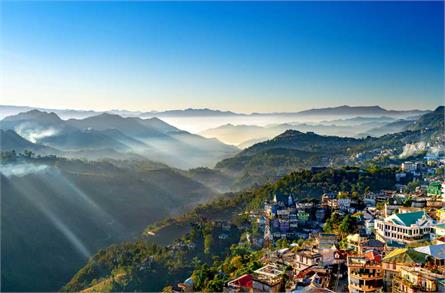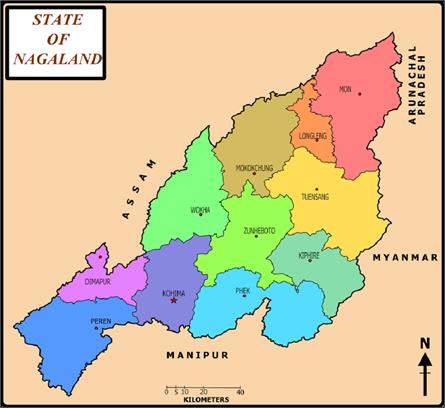Tripura - A Beautiful Land of Tribes
Rich in art and culture, Tripura, a land of nineteen tribes, is nestled in lush green hills and attracts tourists from all over the world with natural beauty and picturesque locations. Located in the northeastern part of India, Tripura is bounded by Mizoram in the east, Assam in the northeast, and Bangladesh in the north, west, and south. It is one of the 'Seven Sister' states, and Agartala is the capital of the state. After Goa and Sikkim, Tripura is the third smallest state in India.
History of Tripura
The history of Tripura is ancient and long. It has its own unique tribal culture and fascinating folklore. It is believed that the state was named Tripura after King Tirupur, who was the 39th king of the Yayati dynasty. According to another legend, it was named Tripura after the local goddess Tripura Sundari, which is one of the 51 Shakti Peethas of Hinduism. The region is also stated in Mahabharata and Puranas. Moreover, the history of this state can be known from the stories of 'Rajmala' and Muslim historians.
Also Read: Guru Gobind Singh Jayanti
Tripura evolved under the command of the Manikya dynasty, the family of Indo-Mongolian, in 1300 AD. In the early 17th century AD, Tripura came under the administration of the Mughals. But the Manikya dynasty retained some of their power. After the British establishment in their colonies in Kolkata, the British also conquered parts of modern Tripura but did not implement any administrative control for more than a century.
Before becoming an integral part of the Republic of India, Tripura was a princely state in the north-eastern part of India. It became a constituent state of the Indian Union on January 21, 1972.
Geography and Climate of Tripura
Tripura, the third smallest state in India, has five longitudinal mountain ranges that go from north to south. The nature of this state is characterized by its plains, valleys, and mountain ranges. Betlingchhip, the highest peak of the state with a height of 930 m, located in the Jampui range. The area of Tripura has spread about 10,492 sq km.
The state of Tripura experiences a less hot and humid climate. The monsoon season receives more than 2,000 mm of rainfall, which continues from June to September. The state is ideally suited for rain, and the region has an average temperature of 35°C in the lowlands during summer.
Also Read: Shikari Devi The Roofless Temple Full of Marvellous Secrets
Government and Politics
A democratic parliamentary system governs the state of Tripura. The people of this state have universal suffrage. The Judiciary, Legislature, and Executive are the three branches of government of Tripura. The High Court of Tripura elects the judiciary or magistrate. The Speaker of Assembly controls meetings and conferences of the Assembly, but in the absence of the Speaker, the Deputy Speaker conducts meetings. Assembly members are elected for five years. The President of India appoints the Governor of the state, and the Governor appoints the Chief Minister. One representative from Tripura goes to the Rajya Sabha and two representatives to the Lok Sabha. Biplab Kumar Deb is the 10th Chief Minister of Tripura since March 9, 2018.
Education and Language
Since the formation of the entire state of Tripura on 21 January 1972, the state has developed at a rapid pace in the field of education. Tripura is a small but wonderful state and provides excellent educational facilities to the students, and the medium of instruction in most schools is Bengali and English. Private schools are being run along with government schools in the state. Many religious institutions imparting religious education are also serving in this small Indian state.
The schools and colleges here are affiliated to the Central Boards and the Tripura Board of Secondary Education.
Also Read: The Divine Power of 12 Jyotirlinga
Economy of Tripura
The economy of Tripura is primarily based on agriculture. The main crop is rice cash crops including jute, cotton tea, sugarcane, mesta, and fruits. Animal husbandry has a supporting role in the agriculture of the state of Tripura. The state of Tripura is predominantly a hilly region. Mainly small scale construction work is done here, which includes many cottage industries like weaving, carpentry, basketry, and pottery production. The state government is active in promoting the development of small scale industries.
Transport
Due to topography, communication is difficult. Tripura is almost detached from the rest of India due to being surrounded by Bangladesh on three sides (839 km). Boats ply in most of the rivers here, but they are used for local transport only. The road quality of the highway is quite poor.
Roadway: The total length of various types of roads in Tripura is 16,931 km. National Highway 44 is the only highway that connects Tripura with the rest of the country and is also called the lifeline of the state.
Railway: Kumarghat railway station is the nearest railway station of the capital city, Agartala. The state has a 202.76 km total length of the Rail line within the state.
Airway: Maharaja Bir Bikram Airport is the major airport located in Agartala. Agartala is connected by air to various cities of Kolkata (West Bengal) and Assam. The air force is also available within the state.
Cultural Life and Festival
Tribal customs, legends, and folklore are essential elements of the culture of Tripura. Bengalis have the largest population in the state, due to which, Bengali culture is the most non-indigenous culture of the state. Many tribal families who live in the city have adopted the Bengali language and culture. Tripuri kings were considered to be the biggest supporters of Bengali culture, especially literature. Tripura is famous for its cane and bamboo handicrafts. Dance and music are integral parts of the culture. The indigenous communities have their own dances and music, which are performed on religious occasions, weddings, and other occasions. At the time of Garia Puja, Jamatia and Tripuri people perform 'Garia dance.' Some of the dance styles of Tripura are - Mamita dance, Jhum Dance, Lebang Boomani dance, Hai Hak Dance, etc.
Without a doubt, Tripura is the second-highest tribal population state in the northeastern region in India. About one-third of the state's population belongs to the tribes, which have their own festivals. Hence, Tripura enjoys various festivals throughout the year with huge pomp and gaiety. Some of their festivals are as follows:
- Poush Sankranti Mela
- Kharchi Puja
- Garia Puja
- Ashokastami Festival
- Diwali Holi
- Bengali New Year
- Boat Race
- Kharchi puja
- Durga Puja
- Ker puja
Tourist Event
- Orange and Tourism Festival
- Neermahal Tourism & Water Festival
- Pilak archaeological & tourism Festival
Shopping in Tripura
Tripura, a tribal-dominated state of India, is rich in bamboo and cane. Due to which, the art of handicrafts is in the veins of people. Handicrafts have traditional importance, and shopping from here will be a pleasant experience.
Tripura's fashion has come out of here over time. Now, apart from bamboo and cane, many things attract people, such as crafts made of clay, wood, palm leaves, and other items. Bamboo and cane furniture made by artisans of Tripura is famous all over the country due to its unique design, superior quality. Agartala, the capital of Tripura, is the best place to shop. The govt. of Tripura also runs a government emporium for shopping.
Best Time to Visit
The best time to visit Tripura is considered from October to May. During the monsoon, tourists should avoid traveling to Tripura.
Best Places to visit in Tripura
Situated in the hills and scenic surroundings, Tripura attracts a large number of tourists. The state's magnificent landscape, lush green forests, crystalline waterfalls, beautiful mountains as well as the state's rich history are truly magnificent.
- Ambassa
- Agartala
- Kailashahar
- Unakoti
- Sipahijola Wildlife Sanctuary
- Sipahijola Wildlife Sanctuary
- Rudrasagar Lake
- Tripureswari Temple
- Trishna Wildlife Sanctuary
- Gunabati Group of Temples
- Neermahal
The state, also tucked in mythology, constitutes an irresistible charm as a tourist destination. Tripura has its own history to tell and is blessed with nature and beautiful landscapes.









